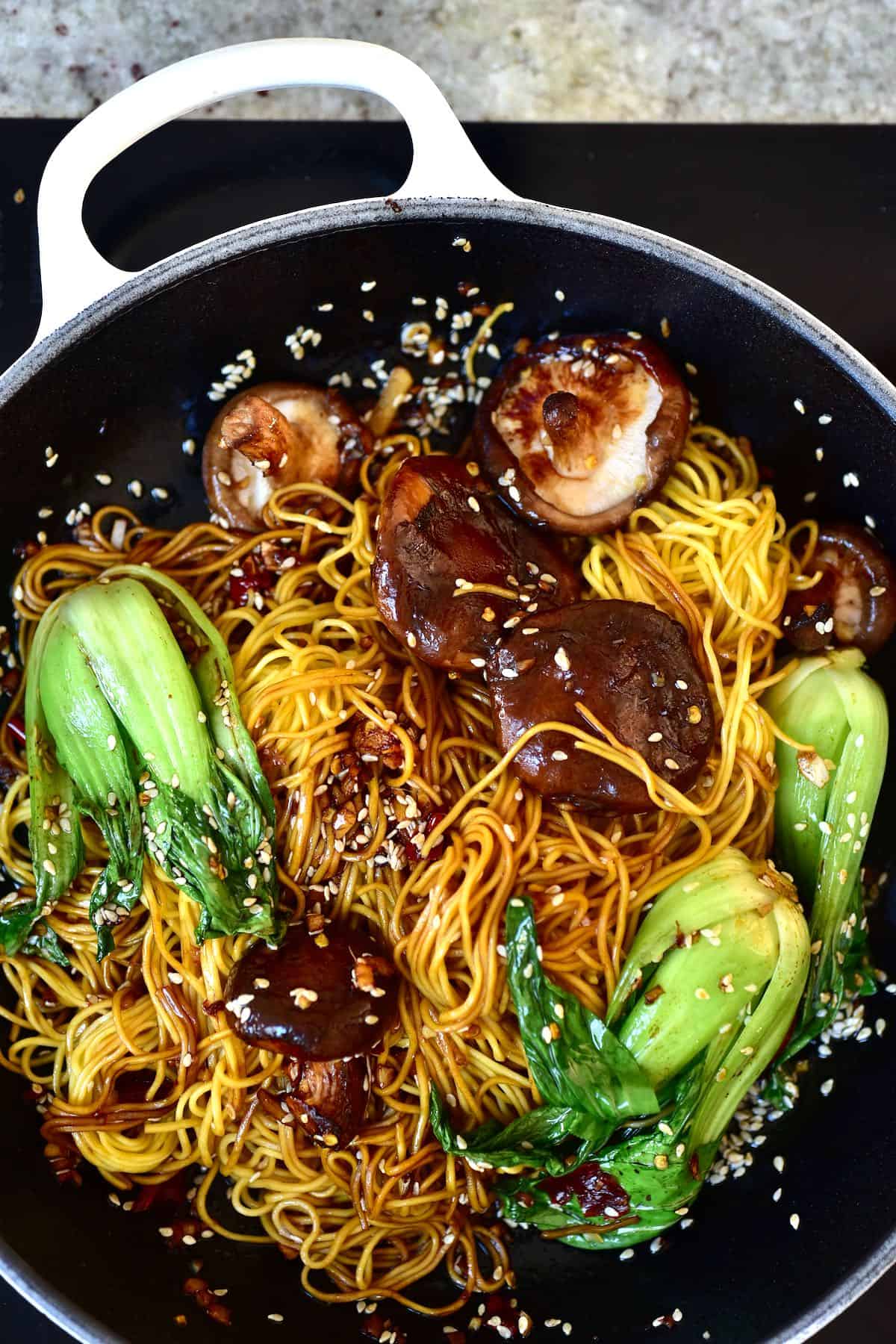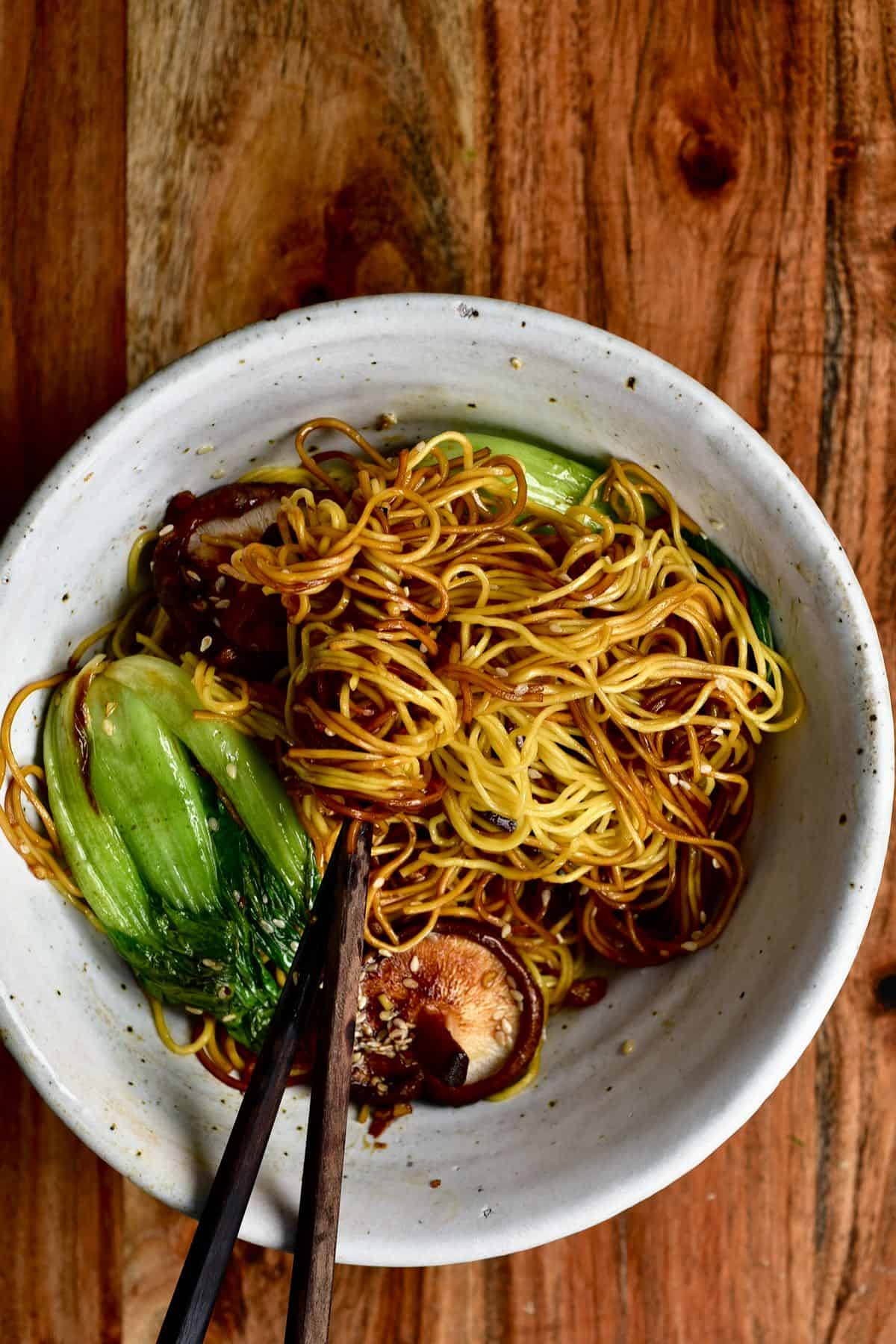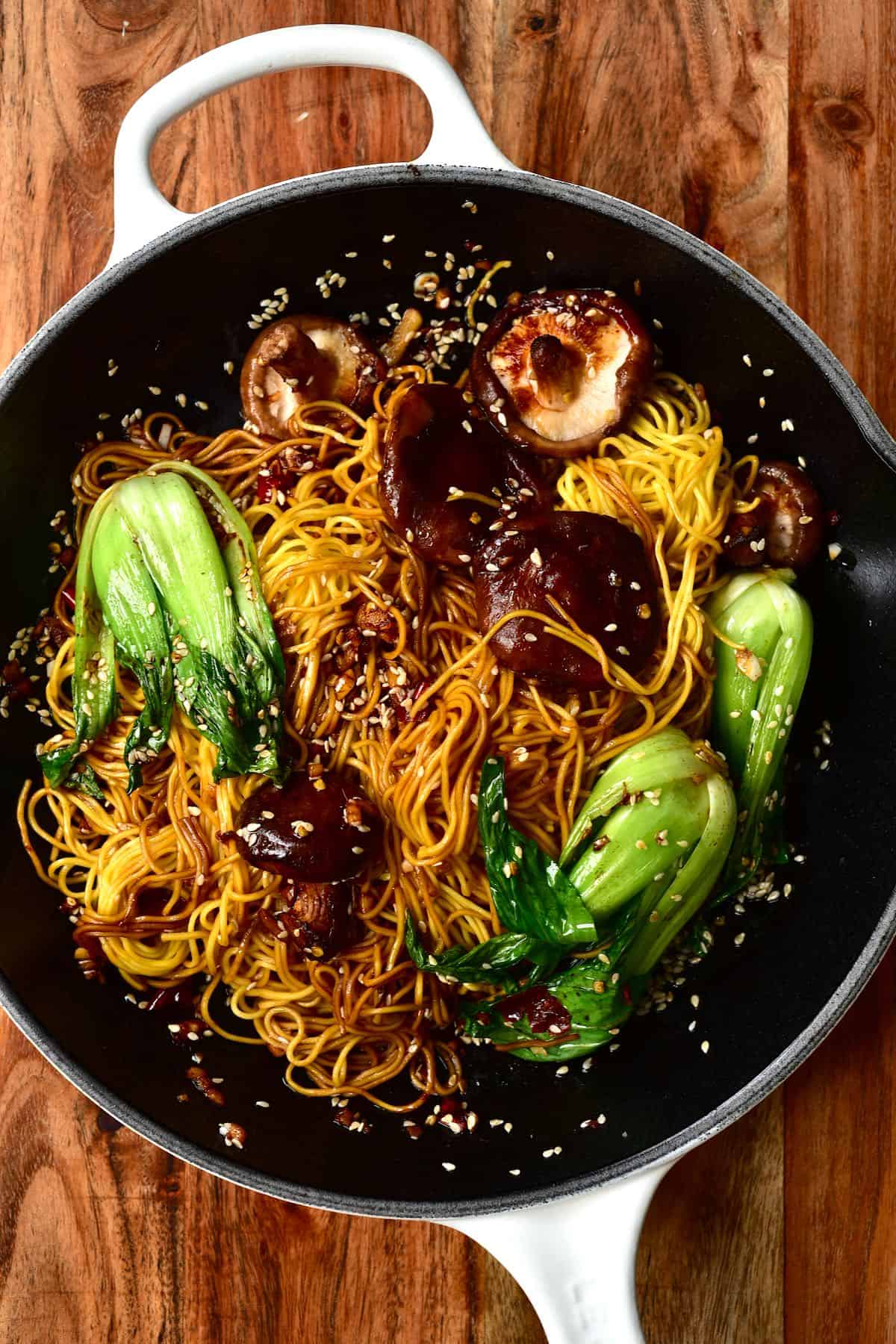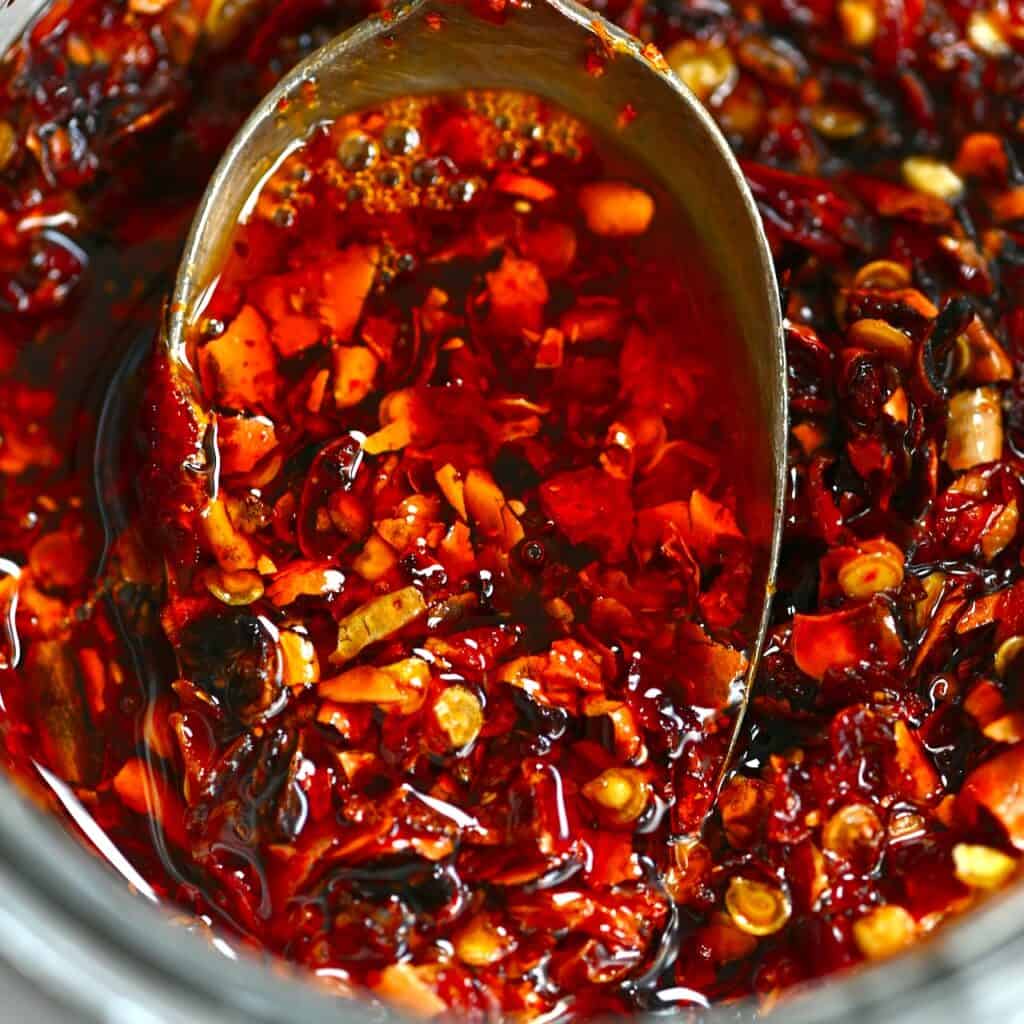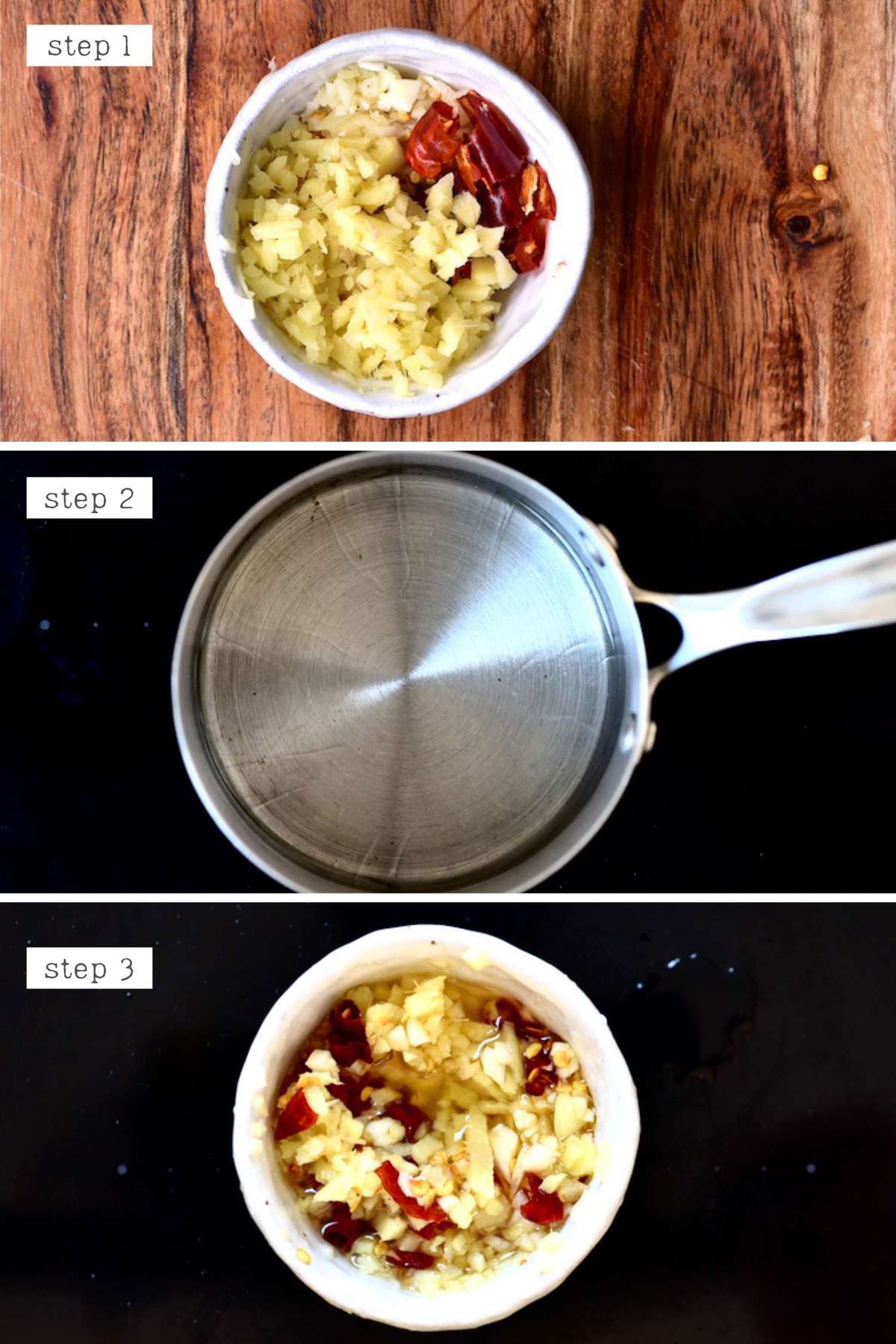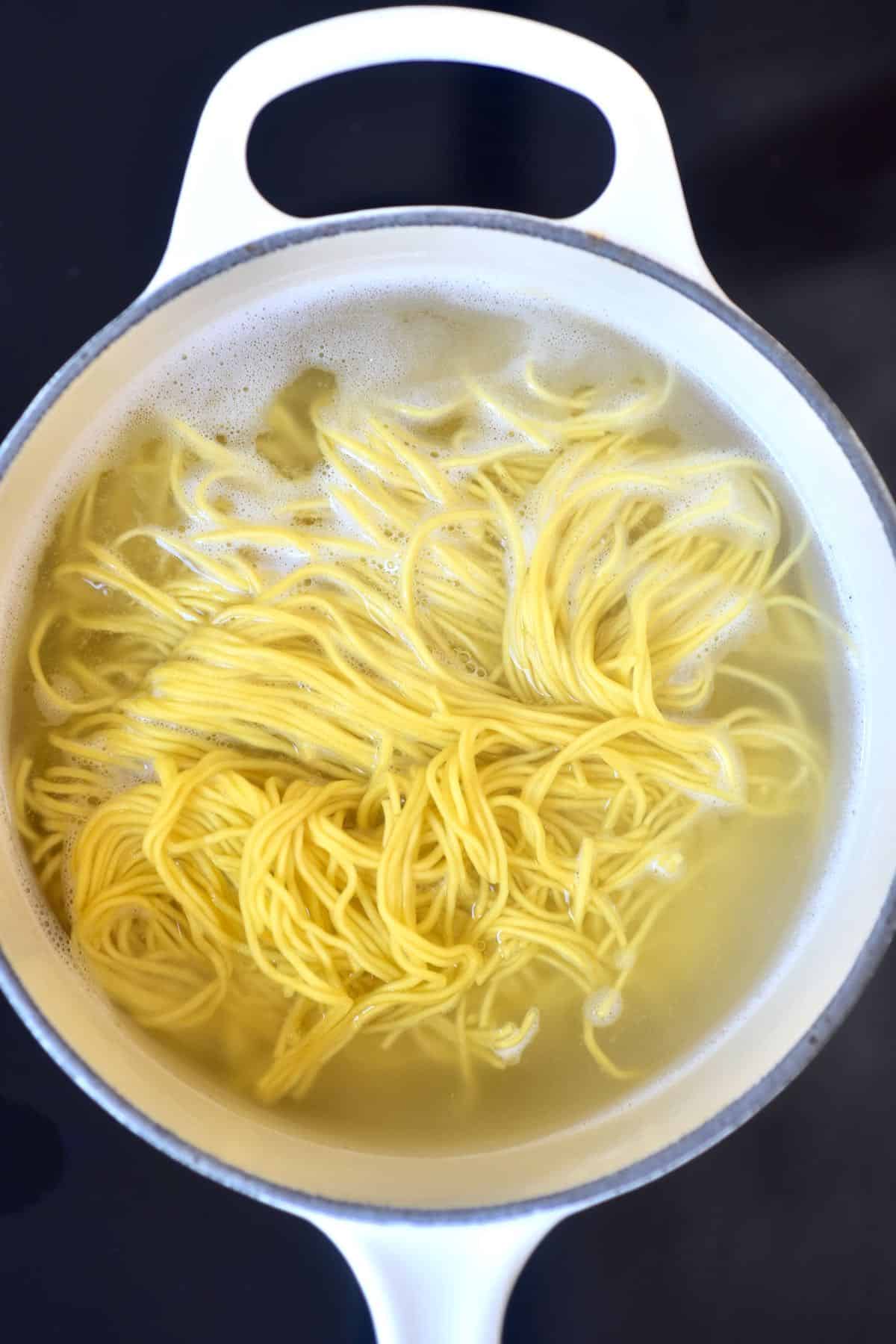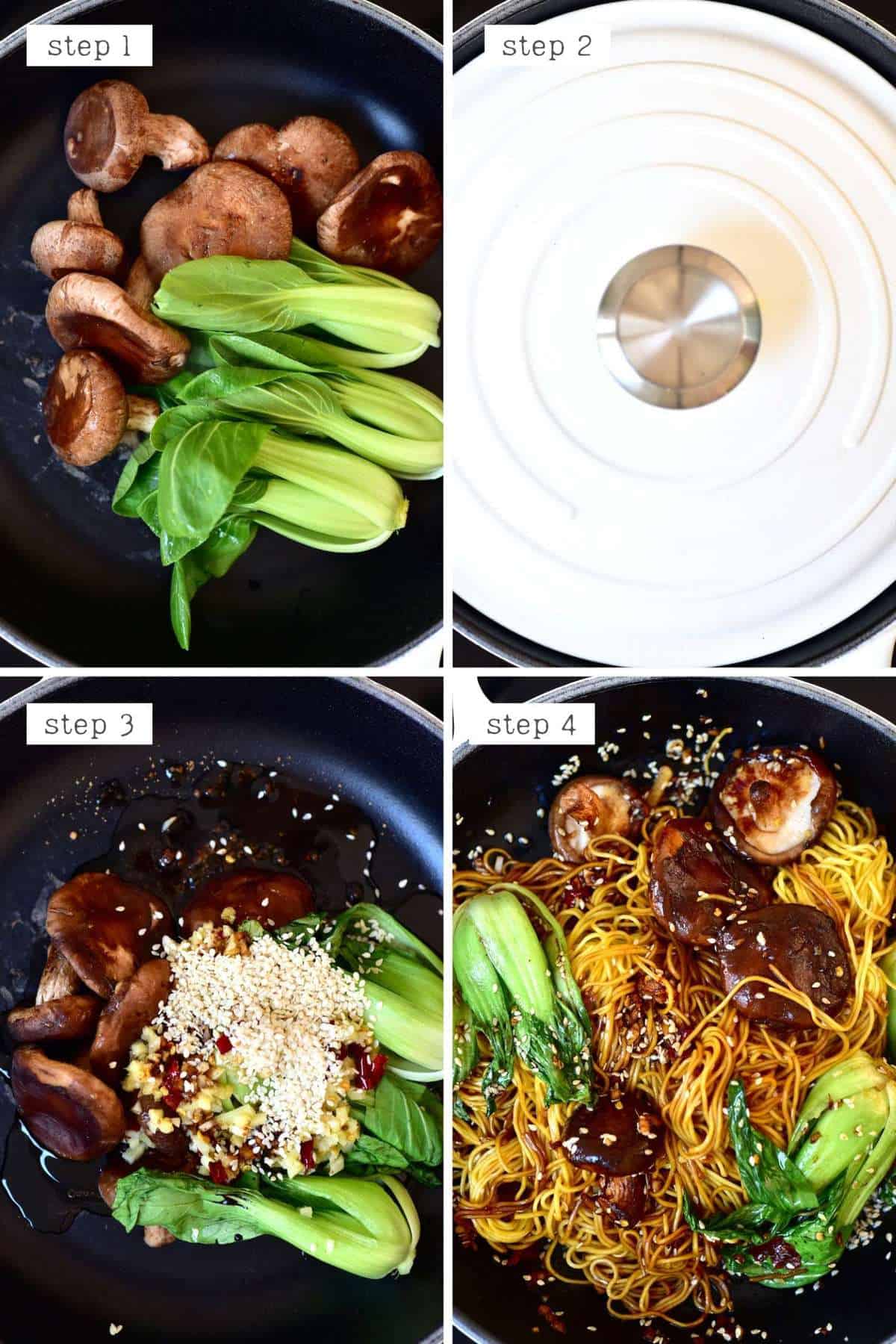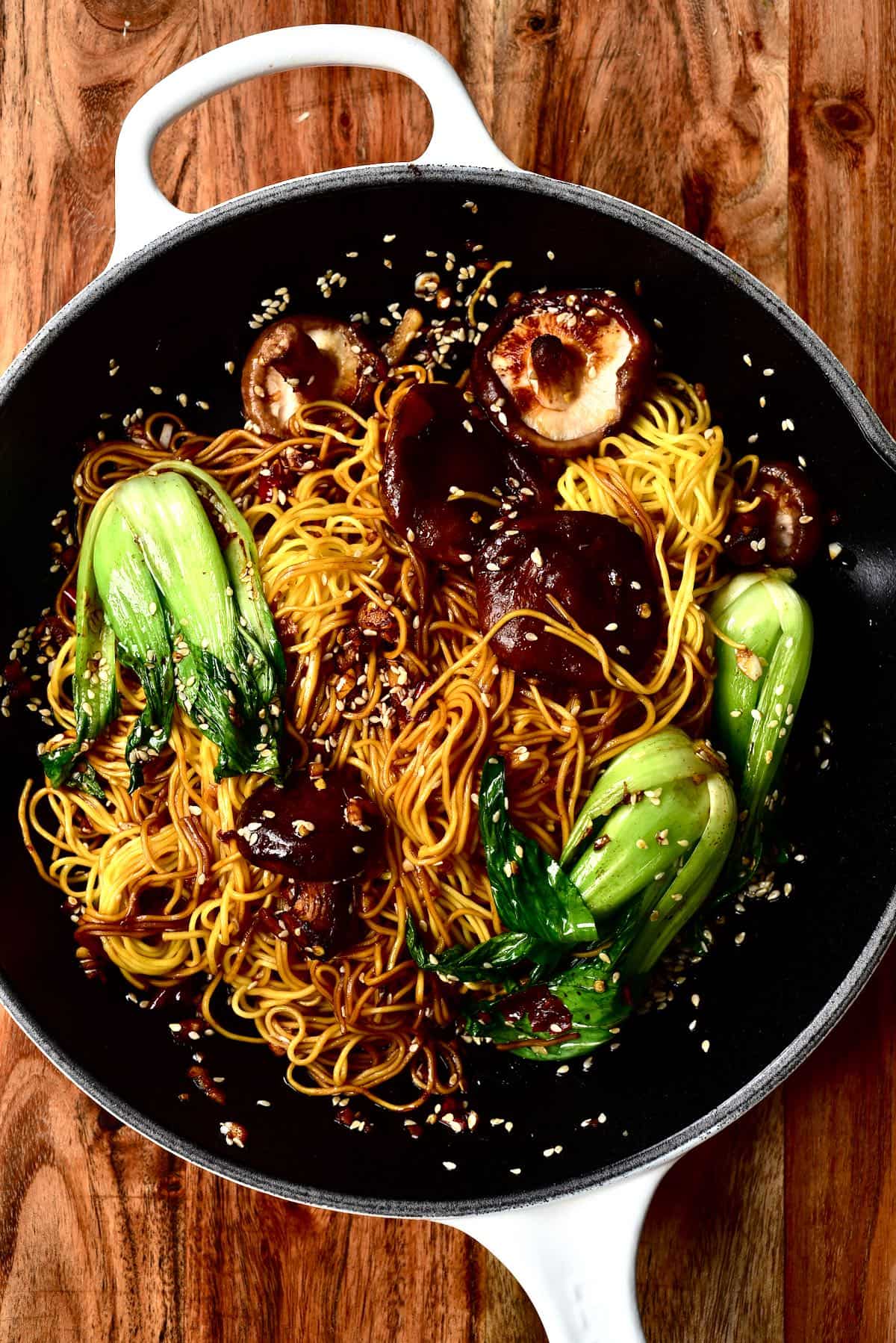I love Asian noodle recipes in any variety – I’ve already shared recipes for a Japchae Korean Glass Noodles and Japanese-inspired Ramen Noodle Soup, and now I’m sharing this simple chili garlic vegetable lo mein. Stir-fry noodles are quick, versatile, and easy to adjust to your liking. You can adjust the amount of spice, sweetness, vegetables, and protein added, even the noodles used! These chili garlic noodles have been inspired somewhat by several types of Asian noodles: Dan Dan noodles, spicy Thai noodles, Chinese chow mein/lo mein. I’ve combined the flavors of chili, garlic, and ginger to make a spicy, flavorful chili garlic oil. And when you add the soy sauce, sesame oil, and a pinch of sugar, you get a sauce that is sweet, spicy, savory, and utterly addictive! Combine that with your favorite veggies, and you’ll have a dish that you’ll return to time and time again! I’ve made this recipe into vegetarian/vegan lo mein (depending on the noodles used) by serving it along with steamed bok choy and mushrooms (often adding some cubed, marinated homemade tofu, too!). However, feel free to use whatever vegetables and protein you have to hand. One of the best things about vegetable stir fry noodles is bringing out almost any of the veggies you need to use in your fridge (as long as their cooking times are similar) and getting to work. Spinach, peppers, onion, courgette, aubergine, etc. You can plan these Asian garlic noodles in advance or use the dish as your ultimate end-of-week ‘fridge clearout’. Chuck it all together into an ultimate, healthy, delicious, filling bowl of vegetable lo mein!
What is Lo Mein?
Here in the UK, there are two main types of Chinese noodle dishes: Lo mein and Chow mein. However, chow mein is the general option you’ll find in takeaways and restaurants. That being said, the question is – what actually are lo mein noodles, and what is the difference between lo mein and chow mein? Both versions refer to Chinese ‘dry’ noodles served with vegetables and often some meat or seafood in a little sauce. However, the difference is in the way that they are prepared. Lo mein usually refers to stirred/tossed noodles in comparison to Chow meins’ stir-fried noodles. For this vegetable lo mein, the noodles are cooked separately (boiled) from the vegetables and then lightly tossed with the veggies and sauce at the end, only in the pan long enough for them to heat through. Check out the recipe notes though, for crispier pan-fried noodles.
The Ingredients
For the noodles
Noodles: the choice of noodles is super versatile. I usually use lo mein/Dan Dan noodles. You could also use ramen, ribbon, udon – even linguine and spaghetti will work! You can also use refrigerated noodles that don’t need to be boiled for an even lower effort meal. A wide array of Asian noodles are available in Asian grocery stores, but several are in mainstream supermarkets too. Vegetables: I used mushrooms and bok choy. Check out the section below for tons more options. (Optional) protein: I often use chopped and marinated homemade tofu for vegan lo mein. You can also use meat or seafood, though, if preferred.
For the lo mein sauce
Soy sauce: or gluten-free tamari/coconut aminos. Sesame Oil: adds a wonderfully nutty aroma.Sugar: I used brown sugar. You could also use maple syrup for a vegan, unrefined sugar option. Sesame seeds: optional but worth the addition.
For the chili oil
Vegetable Oil: or another neutral oil – canola oil, peanut oil, etc. Aromatics: ginger, red chili, and garlic. Change the chili type depending on the flavor and spice levels that you’d like to achieve.
Optional Add-ins
As I said above, these lo mein noodles are one of the ultimate ‘versatile’ dishes. Here are just a few optional ingredients you could add to the vegetable stir-fry noodles.
Other vegetable add-ins: asparagus, bean sprouts, peppers, onion, spinach, courgette, carrots, kale, water chestnuts, sugar snap peas, snow peas, broccoli, cabbage, baby corn, edamame – the sky is your limit. Just make sure they have relatively similar cooking times. You could also use pre-cooked veggies and add them to the pan to heat them through. For a more traditional Chinese/dan dan noodle flavor: add in some five-spice powder and any vinegar to the sauce and lots of chili oil (Sichuan pepper flakes are a bonus too!) along with some ground protein of your choice (I tend to use soy mince). For Super Spicy Asian Noodles: ramp up the spice with extra chili oil and paste/sauce added to the chili noodles! Or you can try this super quick chili oil noodles recipe. Add more depth of flavor to noodle dishes with a combination of light/reduced-sodium soy sauce and dark soy sauce. Dark soy is super-rich and adds depth of umami flavor that just won’t be reached by using light soy alone. Oyster sauce: it also adds depth to the flavor. For vegan lo mein, you could use a vegan fish sauce. Just add a splash and increase to taste. For more smokiness: similar to restaurant-style lo mein, you can add a few drops of liquid smoke. It’s entirely optional but a delicious addition.
For other recipe variations (including adjusting spice levels, sodium content, etc.) then check out the recipe notes section at the bottom of this post!
How To Make Vegetable Lo Mein
Step 1: Prepare the chili garlic oil
First, heat the vegetable oil in a small saucepan. Meanwhile, peel and mince the garlic and ginger. Then add them, along with the dried chili, to a small bowl, Pour the hot oil over the mixture – it will sizzle wonderfully for a while before settling down. You could also use a pre-prepared chili oil and add the garlic and ginger to the pan raw. This will slightly change the flavors of the chili noodles though.
Step 2: Cook the noodles
Depending on which type of noodles you’re making, prepare them according to the package instructions. I usually use specific lo mein/dan dan noodles, which take 3-5 minutes in boiling water. Once cooked, drain.
Step 3: Prepare and saute the vegetables
Depending on what vegetables you decide to use, this step may vary slightly. Add your mushrooms and bok choy (whole or sliced) to a large, pre-heated dry pan (no oil) and cover with a lid for about 5 minutes. Then, remove the lid and add the chili oil and all the sauce ingredients to the pan, mixing well. You can optionally prepare the sauce in a separate small bowl before adding it to the pan. Sometimes. I like to save on the additional washing up by just chucking it right into the pan. Stir-fry the vegetables for a couple of minutes with the sauce.
Step 4: Combine, toss, and serve the vegetable lo mein
Add the noodles to the pan tossing it well, so the sauce is well distributed throughout the dish. Cook until the noodles are heated through, and then serve your chili garlic noodles hot!
How To Make Ahead & Store
To make ahead: you can prepare and store the chili oil and lo mein sauce (separately) in the fridge for 5-7 days before preparing the chili noodles. In the fridge: store leftover vegetable lo mein in an airtight container in the refrigerator for 3-4 days. In the freezer: lo mein can be frozen for up to four months in individual freezer bags/containers. Thaw in the fridge before reheating. However, be aware that certain vegetables may change texture upon thawing. To Reheat: reheat the garlic noodles over the hob or in the microwave. You may need a little extra sauce, as the chili noodles tend to dry out slightly. Or, for more indulgent noodles, you could add a dab of butter (dairy or dairy-free).
Recipe Notes & Variations
For vegan lo mein: make sure to use vegan noodles. Otherwise, this vegetable lo mein recipe is already vegan! Gluten-free: use tamari instead of soy sauce and use any gluten-free noodles. Low-carb: you can swap out the noodles entirely for a low-carb option like zucchini or butternut squash noodles. If doing so, I tend to include extra protein in the recipe to make the chili noodles more filling. To adjust the spice: for more spicy Asian noodles, add a little extra chili oil or chili flakes. You could also add some chili sauce. To change the spice levels either way (more or less), you can pick and choose the chilies you use in the recipe based on how spicy they are and adjust how much is used. To reduce sodium: feel free to use reduced-sodium soy sauce. Add extra garlic for super garlic noodles – I know everyone’s taste preference for garlic is different. If you prefer more saucy chili noodles: feel free to double the sauce recipe minus the sugar and chilies and then add those a little at a time until you achieve the sweetness/spiciness you prefer. You could also add a splash of vegetable broth. For crispier stir-fry noodles: if you want ‘chow mein’ style pan-fried noodles, it’s best to undercook the noodles and add them to the sizzling hot pan, tossing and frying for a few minutes till they begin to become crispy. Then add the sauce right at the end. It’s best to slightly undercook the noodles when boiling/steaming. They will continue to cook when added to the pan. Depending on whether you prefer your vegetables to be crisp or tender, adjust the frying time. You can also add a splash of water to the pan at the beginning of the cooking process and cover them with a lid; this will help the veggies steam.
Other Asian-Inspired Recipes
Rainbow Vegetarian Bibimbap Japanese-inspired Ramen Noodle Soup Stir-Fried Thai Basil Vegan Beef (Pad Krapow) Tom Yum Soup Easy Thai Red Curry (Vegetarian/Vegan Options) Korean Vegetable Pancake (Buchimgae/Pajeon) Chinese Eggplant with Garlic Sauce (Eggplant Stir-Fry) Easy Garlic Chili Oil Noodles (10 Minute Meal!)
If you try this chili garlic vegetable lo mein recipe, then let me know your thoughts and questions in the comments. I’d also really appreciate a recipe rating and would love to see your recreations – just tag @AlphaFoodie.





